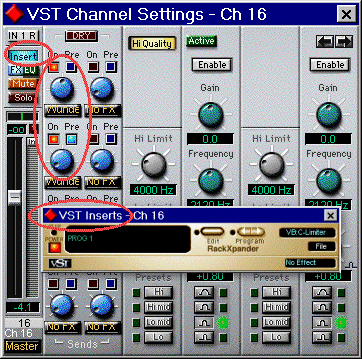Insert or Aux ?

As a matter of fact, rules about this change depending on the result aimed at and circumstances? Fist of all one needs to really understand how these routings work.
- Insert : lSound comes into the mixer channel and from there directly and in its entirety into the insert fx? In case there are several inserts, be aware that sound goes through them one after the other, in serial order and not in parallel.
- Aux Send : Sound comes into the mixer channel, from where it is rerouted to 2 busses: the Master bus where the level will be controlled by a fader, which is a stereo bus, and the aux send, with level controlled using a knob on the mixer channel, which usually is a mono bus. A little switch allows for selecting either "pre" or "post" fader mode, which means that the signal is routed to this bus respectively "before" or "after" level is affected by the mixer channel's fader. The consequences are: in pre-fader mode, the signal is sent at the same level no matter what is the position of the fader, whereas in post-fader mode the fader also affects the level of the signal sent to that bus. Is it clear ?
In both cases, the signal routed to the aux send doesn't go to the master bus?
 Assume a fx is activated as insert? The whole signal of this mixer channel will be affected by that fx, and there's be no way to balance the fx (wet) signal with the original (dry) signal if the fx doesn't provide this feature internally. Now assume that fx is activated on the aux send bus. Rerouting its output to the master bus will allow for balancing dry vs wet signal. Note that Cubase defaults to routing the aux send fx output to the master bus.
Assume a fx is activated as insert? The whole signal of this mixer channel will be affected by that fx, and there's be no way to balance the fx (wet) signal with the original (dry) signal if the fx doesn't provide this feature internally. Now assume that fx is activated on the aux send bus. Rerouting its output to the master bus will allow for balancing dry vs wet signal. Note that Cubase defaults to routing the aux send fx output to the master bus.
OK, that was a quick and dirty summary of the main differences?
Used as an insert, a fx can only affect sound going through that mixer channel, and since it affects the whole signal, (in general), insert fx are used for "processing" the sound such as noise-gates, compressors, exciters, choruses, eqs, tremolos, distortions, magnetos, phasers, specific delays, etc etc?
Pre-fader sends allow for suppressing all dry sound, or for leaving the fx level unaffected by the position of the fader, during an automation phase for instance. That may be useful for some applications such as "dub" mixing, for instance, where the fx almost becomes an instrument of its own? Pre-fader sends may also be used for monitor mix: the level sent to the aux bus (to drive headphones for instance) isn't affected by the main mix settings used for feeding the master bus.
Clever guys will have noticed that, in an attempt to present this subject in a format understand&able by a large audience, I skipped on purpose discussion routing option to sub-groups? To these ones I say that they just need treating the latters as if they were additional master busses in the first place !!! Eh !!!





